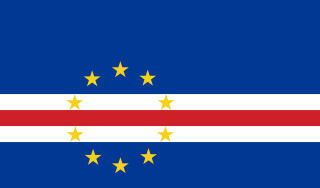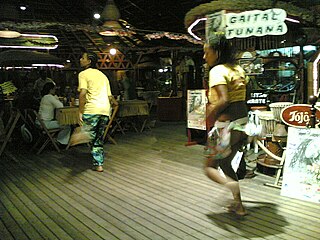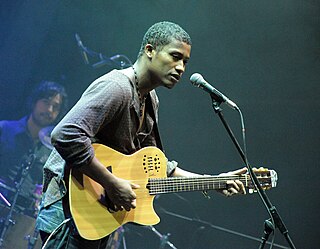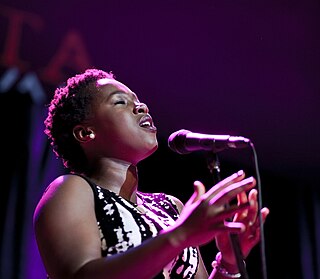
Cape Verde is known internationally for morna, a form of folk music usually sung in the Cape Verdean Creole, accompanied by clarinet, violin, guitar and cavaquinho. Funaná, Coladeira, Batuque and Cabo love are other musical forms.

The morna is a music and dance genre from Cape Verde.

Kizomba is a dance and musical genre that originated in Angola in 1984.

The funaná is a music and dance genre from Cape Verde. Funaná is an accordion-based music. The rhythm is usually provided by the ferrinho much like the use of washboards in zydeco, the saw in Caribbean ripsaw music, the scraper in Sub-Saharan African music and the güiro in Latin and Pre-Columbian music.
The coladeira is a music genre from the Cape Verde islands in the central Atlantic Ocean.

Cesária ÉvoraGCIH was a Cape Verdean singer known for singing morna, a genre of music from Cape Verde, in her native Cape Verdean Creole. Her songs were often devoted to themes of love, homesickness, nostalgia, and the history of the Cape Verdean people. She was known for performing barefoot and for her habit of smoking and drinking on stage during intermissions. Évora's music has received many accolades, including a Grammy Award in 2004, and it has influenced many Cape Verde diaspora musicians as well as American pop singer Madonna. Évora is also known as Cizé, the Barefoot Diva, and the Queen of Morna.

The ferrinho is a musical instrument, more precisely a scraped idiophone. It is made up by a metal bar that is scraped by another metal object. The player holds the bar vertically, with its lower end in the palm of one hand and the upper end leaning against the shoulder. With the other hand, the player uses a metallic object, held horizontally, to scrape the bar with up-and-down movements. A custom-made ferrinho is usually 90 centimeters long, with a straight-angle section to ease handling.
Tabanka is a musical genre of Cape Verdean music.

Tcheka is a Cape Verdean singer, songwriter and guitarist, who is well known for his work in transposing the traditional genre batuque to the electro-acoustic guitar.

Batuque, the Soul of a People is a 2006 documentary film written and directed by Júlio Silvão Tavares about the batuque musical group Raiz di Tambarina, and roots of this musical genre in Santiago, Cape Verde.

The history of the cinema of Cape Verde dates back to the arrival of filmmakers in the early twentieth century. The first picture house was established in Mindelo around 1922, called Eden Park.
Vadú, nickname of Osvaldo Furtado, was a Cape Verdean singer and musician. He defined himself as a real "Badiu" or ironically as a "civilized Black".
Codé di Dona, nickname of Gregório Vaz, was a Cape Verdean musician and composer.

Elida Almeida is a Cape Verdean singer.

Quintal da Música, abbreviation: 5tal da Música is a music pub located in the downtown area of Praia, the Plateau and is located at 70A Avenida Amílcar Cabral in the northern part of the center, across Rua António Pusich and south of Rua António Macedo. It is one of the most famous and most used pubs and music pubs in Cape Verde.
The Culture of the Island of Santiago, Cape Verde is the richest in the nation, with a range of customs and practices common in the islands,

Colá is a musical genre of Cape Verdean music
Carlos Filipe Fernandes da Silva Gonçalves is a Capeverdean journalist and an investigator, ex-director of the Portuguese station Rádio Comercial. Carlos Gonçalves has made interviews, conversations and meetings and found written documents by different authors, mainly those from the late 20th century on Cape Verdean Music.
Kap Verd Band or Kab Verd Band is a music history book published in 2006 by Cape Verdean journalist and investigator Carlos Filipe Gonçalves. It was published by the Institute of the National Historic Archives and has been distributed and marketed by the National Library Institute.
"Batuka" is a song recorded by American singer-songwriter Madonna for her fourteenth studio album, Madame X (2019). The song was written by Madonna and her son David Banda, alongside her longtime collaborator Mirwais, while produced by Madonna and the latter of the three. It features the Batukadeiras Orchestra, an all-women group that play drums on the song. It is a batuque song with influences of Afrobeat, featuring a call and response structure, and the lyrics of the song are about "overcoming adversity".













